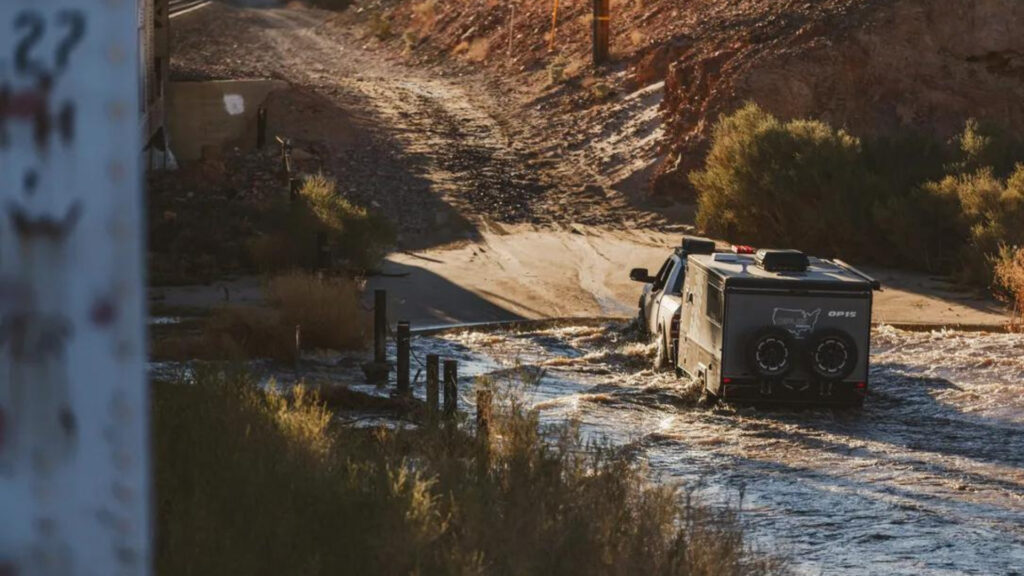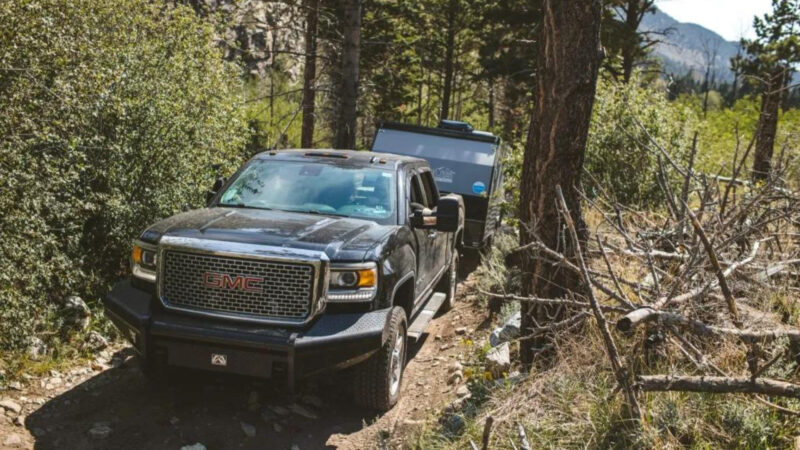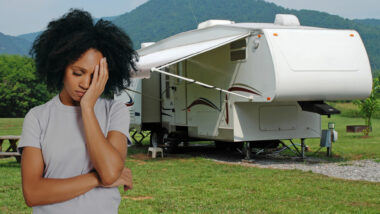Table of Contents Show
Some people love driving to an RV resort, pulling into a full hookup campsite, and heading to the campground swimming pool. But some RVers may prefer a more adventurous journey.
If off-roading and off-grid camping is more your style, you’ll want to check out these all-terrain RVs built for getting away from the typical camping lifestyle and embracing the outdoors.
Does this sound like you? Let’s dive in!
What Is an All-Terrain RV?
Sometimes called an off-road RV, an all-terrain RV is built for traveling off the beaten path. By getting into the heart of nature, travelers can experience more solitude and truly feel more connected with the outdoors.
Whether you want to venture deep into a national forest or get off the highway onto the rugged landscape of the Southwest, an all-terrain RV can take you almost anywhere.
What Makes an All-Terrain RV Different from Standard RVs?
When you go to a campground you’ll find standard RVs. These trailers and motorhomes range in luxury and style. There are 35-foot fifth wheels with two slides, a kitchen island, and a king bed.
There are 42-foot toy haulers with three slides, a 13-foot garage, and places for up to eight people to sleep. And there are 25-foot Class C motorhomes with a slide, a cabover bed, and enough room for one or two people. When shopping for a standard RV, you’ll discover many options and floorplans.
However, the all-terrain RVs that overlanders prefer differ from the standard RVs most travelers choose when it comes to build quality. Standard RVs aren’t made to travel off flat surfaces.
On the other hand, off-road RVs have a higher clearance and are equipped with off-road tires. These units also have an upgraded suspension, four-wheel drive capabilities, skid plates, side rails, and other added protective components. Usually, these units are smaller than standard RVs.

Why Would Someone Want an Off-Road RV?
Why would someone want a smaller space when RVs already lack privacy?
Adventurers who want to get close to trailheads or kayak launches choose all-terrain RVs because they spend most of their time outside. They don’t need the amenities and luxuries of a Class A motorhome when they’re on the trails eight hours a day ATVing, biking, or hiking.
Some travelers may not necessarily enjoy the thrills of outdoor recreation but may prefer to camp in isolated or secluded areas. Often these locations prove difficult to reach without high clearance and four-wheel drive capabilities.
And when you travel along these dirt paths, rocky gravel surfaces, or washboard roads, you want a vehicle that’s going to arrive in one piece. Skid plates, side rails, and upgraded suspension make traveling off the beaten path easier and safer.
5 Best All-Terrain RVs To Take You Anywhere
If you’re looking for an all-terrain RV to take you anywhere, we have a great list for you.
From the family-friendly Mantis to the drivable Storyteller Overland, we have good options for all types of travelers looking to connect more with nature.
Best Teardrop: Colorado Teardrops Summit Pinnacle
If you prefer a teardrop design, it doesn’t get much better than a Colorado Teardrop. Built for adventuring, the Summit Pinnacle model sleeps up to four people.
The upgrades include 33-inch off-road tires, 21-inch clearance, and a Timbren axle-less suspension for easy off-road accessibility.
The interior features a queen mattress and two bunks, and this space can also be converted into a dining area.
The rear galley has everything you need for a weekend camping trip. The Summit Pinnacle weighs 1,850 pounds, measures 173 inches long, and has an interior cabin height of 57 inches. Pricing starts at $39,800.
Best For Families: Taxa Outdoors Mantis 5.2
The 19-foot Taxa Outdoors Mantis 5.2 has a dry weight of 3,115 pounds. The interior height when opened measures 5 feet 11 inches to 7 feet 10 inches. When closed, the Mantis is less than 7 feet tall, which means it can be stored in a typical garage.
This option works great for families because of the ample storage solutions and versatile interior. It has a kitchen, bathroom, desk, and dining space as well as a full bed sleeping area and an optional bunk bed system. You can even add a hammock or rooftop tent to increase the sleeping space.
The off-road features of the Mantis include 15-inch alloy wheels with all-terrain tires, powder-coated steel chassis, torsion axle suspension with electric brakes, and steel gravel guards.
If you want even more off-road capabilities, you can also check out the Mantis Overland edition.
Pro Tip: Before you dry camp for the first time, here’s everything you need to know!
Best Hybrid Camper: Opus OP15
The OP15 trailer features a king bed, bunk beds, bathroom, and dining lounge.
The pop-up roof increases the standing height inside the unit for a comfortable space. In addition, the outdoor full kitchen includes a 4-burner stove, 12-Volt fridge/freezer combo, and a flip-down prep space.
For camping off-grid, it comes equipped with three AGM batteries that can be upgraded to lithium, 300 Watts of solar, and two freshwater tanks adding up to 63 gallons.
The all-terrain features include an independent trailing arm suspension, dual shock absorbers, a DO35 Cruisemaster hitch, a fully galvanized welded chassis, a front stone guard, and two all-terrain tires with two spares.
The Opus OP15 has a GVWR of 6,393 pounds, a length of 23 feet, and a closed height of 5 feet 5 inches. Once opened, the interior height increases to 6 feet 5 inches.
Best Class B: Storyteller Overland Beast Mode
The Storyteller Overland Beast Mode starts at $218,620. This all-terrain RV measures 21 feet long, 10 feet 3 inches tall, and has a GVWR of 9,050 pounds. Built on a Mercedes-Benz Sprinter chassis, this camper van has a 144-inch wheelbase and includes a 4×4 package.
The Beast Mode features include a KC HiLiTES 360° lighting package, matte black wheels with all-terrain tires, fender flares, a hood spoiler, and an Agile off-road ride improvement package. In addition, the 90-Watt solar panel can be expanded to up to 600W.
Inside, you’ll find 103 square feet of rear storage for all of your outdoor gear.
There’s also a portable toilet, sink, portable induction cooktop, a lounge with a removable table, and front swivel captain’s chairs. The Dreamweaver bed folds out above the garage storage for a comfortable sleeping space.
Keep in Mind: You’ve Heard About 4×4 But What About 6×6? Click the link to see if a 6×6 is right for you!
Best Luxury Expedition Vehicle: EarthRoamer HD
If money is no object, splurging on the EarthRoamer HD will certainly turn heads. This all-terrain RV runs completely self-sufficient with no propane or generator.
The 20,000-Watt lithium battery bank, massive 2100-Watt solar array, and huge tank and fuel capacities will allow you to camp for as long as you want off-grid.
The EarthRoamer HD is built on a heavy-duty Ford F-750 4WD chassis and powered by a 6.7L V8 turbo diesel engine. You can choose from six different floorplans, all of which have a rear sleeping space and a front dining area.
A few of the luxurious features include the in-floor radiant heating, which eliminates cold spots and drafts, a washer and dryer, and a dry bath.
The EarthRoamer HD isn’t for everyone. The starting price is $1.9 million. It’s also larger than most all-terrain RVs. It measures 35 feet in length and has a GVWR of 37,000 pounds.
Tips For Dry Camping
When you venture off the beaten path, you won’t have hookups. Thus, you’ll have to make some sacrifices to enjoy the solitude and serenity of these types of locations. Here are a few tips for dry camping if you’re new to this lifestyle.
First, make sure your freshwater tank is full before you arrive. You might be 30 minutes away from the nearest potable water source, so you don’t want to run out of water in two days.
You also want to make sure your gray and black tanks are empty. That way you won’t have to run to the dump station, which could also be at least 30 minutes away, the next day.
You’ll find conserving water essential to enjoy dry camping for long periods of time. Don’t run the faucet when brushing your teeth or washing dishes.
Take quick showers. Be conscious of your water usage to extend the length of your stay without having to fill up the fresh water tank or empty your gray and black tanks.
You’re also going to have to figure out how to get power. If you have solar panels, they’ll replenish your batteries during the day.
A generator can also recharge your batteries. Make sure you come prepared so you’re not going to have to run to the nearest campground to plug into a power pedestal.
Propane also provides power, so make sure your tanks are full before arriving. Some RV refrigerators receive power from propane, and your RV furnace will get power from propane.
You can also cook using your propane tanks. In order to eliminate having to run out to get more propane, make sure you’re prepared ahead of time.
Adventure Anywhere With an All-Terrain RV
If you want to drive down a washboard road in Utah to get a stellar view of canyons, spires, and monoliths, you will need an all-terrain RV to get there.
Depending on how many people will be traveling with you and your specific camping needs, you’ll find some great options. These RVs are built solidly so you can travel safely off-road, allowing you to enjoy the dry camping experience you’ve been longing for.
Is an off-road RV in your future?






